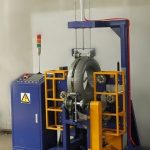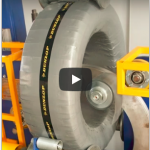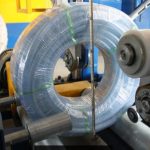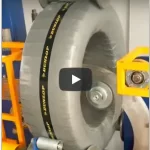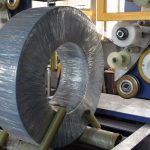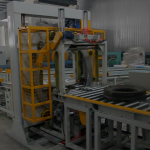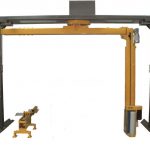A Side-by-Side Comparison of Leading Tyre Wrapping Machine Technologies
In the fast-paced world of automotive manufacturing and tire distribution, efficiency is key. One of the most crucial steps in getting tires from the factory to the consumer is the wrapping process. Tyre wrapping machines have revolutionized this aspect of the industry, offering speed, consistency, and cost-effectiveness that manual wrapping simply can't match. But with so many options on the market, how do you choose the right technology for your business? Let's dive into a comprehensive comparison of the leading tyre wrapping machine technologies to help you make an informed decision.
Understanding the Basics of Tyre Wrapping Machines
Before we delve into the specifics of different technologies, it's important to understand what a tyre wrapping machine does and why it's so essential in today's market. Tyre wrapping machines automate the process of packaging tires for storage and shipment. They typically apply a protective film or wrap around individual tires or stacks of tires, securing them for transport and protecting them from environmental factors like dust, moisture, and UV rays.
The benefits of using these machines include:
- Increased productivity
- Consistent wrapping quality
- Reduced labor costs
- Improved safety for workers
- Enhanced product protection
Now that we've covered the basics, let's explore the leading technologies in the market.
Stretch Wrap Technology: The Industry Staple
Stretch wrap technology has been a cornerstone in the tyre wrapping industry for decades. This method uses a stretchable plastic film that's wrapped tightly around the tire or stack of tires.
How It Works
Stretch wrap machines typically operate by rotating the tires on a turntable while a film delivery system moves up and down, wrapping the film around the tires. The film is stretched as it's applied, creating tension that holds the tires securely.
Advantages
- Cost-effective: Stretch film is relatively inexpensive.
- Versatile: Can handle various tire sizes and quantities.
- Adjustable: Wrap tension can be easily modified.
Disadvantages
- Environmental concerns: Most stretch films are not biodegradable.
- Limited protection: May not provide as much protection against punctures or harsh environments as some other methods.
Shrink Wrap Technology: Tight Fit for Premium Protection
Shrink wrap technology offers a different approach to tire packaging. This method uses a film that shrinks tightly around the tires when heat is applied.
How It Works
Tires are first loosely wrapped in shrink film. They then pass through a heat tunnel or are exposed to heat guns, causing the film to shrink and conform tightly to the shape of the tires.
Advantages
- Superior protection: Creates a tight, tamper-evident seal.
- Professional appearance: Results in a smooth, retail-ready look.
- Moisture resistance: Provides excellent protection against environmental factors.
Disadvantages
- Energy intensive: Requires heat for the shrinking process, increasing energy costs.
- More expensive: Shrink film and the necessary heating equipment can be costlier than stretch wrap systems.
Robotic Wrapping Systems: The Future of Automation
As we move into an era of increased automation, robotic wrapping systems are gaining traction in the tyre wrapping industry.
How It Works
Robotic systems use programmable arms equipped with film dispensers to wrap tires. These systems can be highly customized to wrap tires in specific patterns or to handle unique tire configurations.
Advantages
- High precision: Offers consistent, repeatable wrapping patterns.
- Flexibility: Can be programmed for various tire sizes and wrapping styles.
- Space-efficient: Often have a smaller footprint than traditional systems.
Disadvantages
- Higher initial cost: Robotic systems typically require a larger upfront investment.
- Complexity: May require specialized maintenance and programming skills.
Banding Technology: Simplicity Meets Efficiency
While not as common as stretch or shrink wrap, banding technology offers a unique approach to tire securing and bundling.
How It Works
Banding machines apply one or more strong plastic or metal bands around a stack of tires, holding them together securely.
Advantages
- Speed: Can secure a stack of tires very quickly.
- Material efficiency: Uses less material than full wrap methods.
- Strength: Provides excellent stability for heavy loads.
Disadvantages
- Limited protection: Doesn't offer full coverage protection like wrapping methods.
- Potential tire damage: If not properly applied, bands could potentially damage tire sidewalls.
Biodegradable Wrapping Solutions: The Eco-Friendly Option
As environmental concerns become increasingly important, biodegradable wrapping solutions are emerging as a significant trend in the industry.
How It Works
These systems use films made from biodegradable materials, such as plant-based plastics. The wrapping process is similar to traditional stretch or shrink wrap methods.
Advantages
- Environmentally friendly: Reduces plastic waste and carbon footprint.
- Positive brand image: Appeals to environmentally conscious consumers and businesses.
- Regulatory compliance: Helps meet increasingly strict environmental regulations.
Disadvantages
- Higher material cost: Biodegradable films are often more expensive than traditional plastics.
- Performance concerns: Some biodegradable films may not offer the same level of strength or protection as traditional materials.
Hybrid Systems: The Best of Multiple Worlds
Some manufacturers are now offering hybrid tyre wrapping systems that combine multiple technologies for optimal results.
How It Works
Hybrid systems might, for example, combine stretch wrapping with banding, or incorporate robotic elements into a traditional shrink wrap line.
Advantages
- Versatility: Can handle a wide range of tire sizes and packaging requirements.
- Customization: Allows businesses to tailor the wrapping process to their specific needs.
- Future-proofing: Easier to adapt to changing market demands.
Disadvantages
- Complexity: May require more training and maintenance than single-technology systems.
- Cost: Hybrid systems can be more expensive due to their advanced capabilities.
Vertical Wrapping Technology: Space-Saving Innovation
For facilities with limited floor space, vertical wrapping technology offers an innovative solution.
How It Works
These machines wrap tires in a vertical orientation, often using a rotating arm that applies film as it moves around the tire stack.
Advantages
- Space efficiency: Ideal for facilities with limited floor space.
- Ergonomics: Can be easier for operators to load and unload.
- Unique wrapping patterns: Allows for different wrapping styles that may be beneficial for certain tire types.
Disadvantages
- Limited stack height: May not be suitable for very tall stacks of tires.
- Specialized film: Often requires film specifically designed for vertical wrapping.
Automatic vs. Semi-Automatic Systems: Choosing the Right Level of Automation
When comparing tyre wrapping technologies, it's crucial to consider the level of automation that best suits your needs.
Automatic Systems
Fully automatic systems require minimal human intervention, handling the entire wrapping process from loading to unloading.
Advantages
- High throughput: Can handle large volumes of tires quickly.
- Consistency: Provides uniform wrapping results.
- Labor savings: Reduces the need for manual labor.
Disadvantages
- Higher initial cost: Automatic systems are typically more expensive upfront.
- Less flexibility: May be harder to adapt to varying tire sizes or wrapping requirements.
Semi-Automatic Systems
Semi-automatic machines require some operator involvement, typically for loading and unloading tires.
Advantages
- Lower cost: Generally less expensive than fully automatic systems.
- Flexibility: Often easier to adapt to different tire sizes or wrapping needs.
- Simplicity: Usually easier to maintain and repair.
Disadvantages
- Lower throughput: Cannot match the speed of fully automatic systems.
- Labor requirements: Still requires significant operator involvement.
Comparing Energy Efficiency Across Technologies
In today's environmentally conscious market, energy efficiency is a crucial factor to consider when choosing a tyre wrapping machine.
Stretch Wrap Systems
Generally have lower energy requirements as they don't need heat.
Shrink Wrap Systems
Typically have higher energy consumption due to the heat required for shrinking.
Robotic Systems
Energy efficiency can vary widely depending on the specific system design.
Banding Systems
Often have low energy requirements due to their mechanical nature.
Biodegradable Systems
Energy efficiency is similar to traditional stretch or shrink systems, depending on the specific technology used.
When comparing energy efficiency, it's important to look beyond just the energy used during operation. Consider factors like standby power consumption and the energy required to produce the wrapping materials.
The Impact of Industry 4.0 on Tyre Wrapping Technology
The concept of Industry 4.0, or the Fourth Industrial Revolution, is having a significant impact on tyre wrapping machine technology.
Connectivity and Data Collection
Modern tyre wrapping machines are increasingly equipped with sensors and connectivity features that allow for real-time monitoring and data collection.
Predictive Maintenance
Advanced systems can predict when maintenance is needed, reducing downtime and extending machine life.
Integration with Factory Systems
Tyre wrapping machines can now be integrated with broader factory management systems for improved efficiency and inventory control.
Customization and Flexibility
Industry 4.0 technologies allow for greater customization and flexibility in wrapping processes, enabling manufacturers to quickly adapt to changing market demands.
Conclusion: Choosing the Right Tyre Wrapping Technology for Your Needs
As we've seen, there's no one-size-fits-all solution when it comes to tyre wrapping machines. The best technology for your business will depend on a variety of factors, including your production volume, available space, energy efficiency requirements, and specific wrapping needs.
Stretch wrap systems offer a cost-effective and versatile solution, while shrink wrap provides superior protection. Robotic systems bring precision and flexibility to the table, and banding offers simplicity and strength. Biodegradable solutions cater to growing environmental concerns, while hybrid systems provide the best of multiple technologies.
When making your decision, consider not just the upfront costs, but also long-term factors like energy efficiency, maintenance requirements, and adaptability to future needs. Don't forget to factor in the impact of Industry 4.0 technologies, which can provide valuable data and improve overall operational efficiency.
Ultimately, the right tyre wrapping machine will streamline your operations, improve your product protection, and contribute to your bottom line. By carefully comparing the available technologies and aligning them with your specific needs, you can make an informed decision that will serve your business well for years to come.
